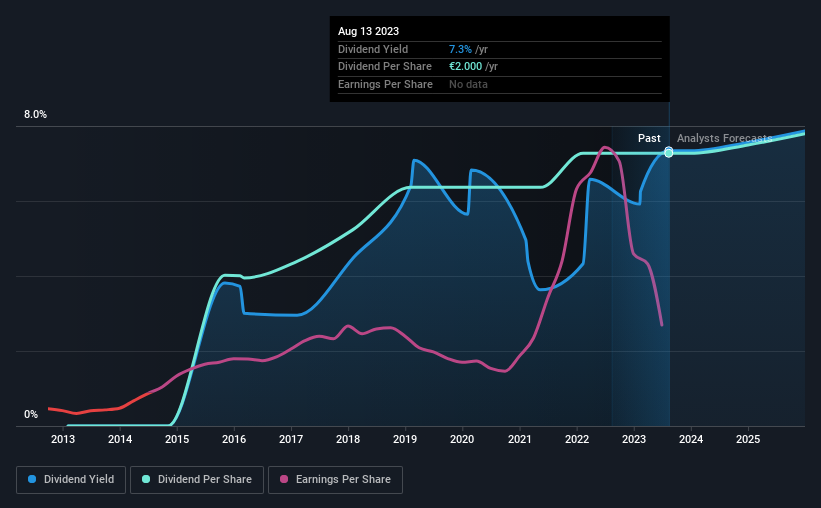Is It Smart To Buy Aperam S.A. (AMS:APAM) Before It Goes Ex-Dividend?
Readers hoping to buy Aperam S.A. (AMS:APAM) for its dividend will need to make their move shortly, as the stock is about to trade ex-dividend. Typically, the ex-dividend date is one business day before the record date which is the date on which a company determines the shareholders eligible to receive a dividend. It is important to be aware of the ex-dividend date because any trade on the stock needs to have been settled on or before the record date. Meaning, you will need to purchase Aperam's shares before the 18th of August to receive the dividend, which will be paid on the 14th of September.
The company's next dividend payment will be €0.42 per share. Last year, in total, the company distributed €2.00 to shareholders. Based on the last year's worth of payments, Aperam has a trailing yield of 7.3% on the current stock price of €27.25. Dividends are an important source of income to many shareholders, but the health of the business is crucial to maintaining those dividends. We need to see whether the dividend is covered by earnings and if it's growing.
Check out our latest analysis for Aperam
Dividends are typically paid out of company income, so if a company pays out more than it earned, its dividend is usually at a higher risk of being cut. Fortunately Aperam's payout ratio is modest, at just 49% of profit. A useful secondary check can be to evaluate whether Aperam generated enough free cash flow to afford its dividend. It distributed 39% of its free cash flow as dividends, a comfortable payout level for most companies.
It's positive to see that Aperam's dividend is covered by both profits and cash flow, since this is generally a sign that the dividend is sustainable, and a lower payout ratio usually suggests a greater margin of safety before the dividend gets cut.
Click here to see the company's payout ratio, plus analyst estimates of its future dividends.
Have Earnings And Dividends Been Growing?
Stocks with flat earnings can still be attractive dividend payers, but it is important to be more conservative with your approach and demand a greater margin for safety when it comes to dividend sustainability. Investors love dividends, so if earnings fall and the dividend is reduced, expect a stock to be sold off heavily at the same time. That explains why we're not overly excited about Aperam's flat earnings over the past five years. It's better than seeing them drop, certainly, but over the long term, all of the best dividend stocks are able to meaningfully grow their earnings per share. Earnings per share growth in recent times has not been a standout. However, companies that see their growth slow can often choose to pay out a greater percentage of earnings to shareholders, which could see the dividend continue to rise.
Another key way to measure a company's dividend prospects is by measuring its historical rate of dividend growth. Aperam has delivered 7.7% dividend growth per year on average over the past eight years.
Final Takeaway
Should investors buy Aperam for the upcoming dividend? The company has barely grown earnings per share over this time, but at least it's paying out a decently low percentage of its earnings and cashflow as dividends. This could suggest management is reinvesting in future growth opportunities. We would prefer to see earnings growing faster, but the best dividend stocks over the long term typically combine strong earnings per share growth with a low payout ratio, and Aperam is halfway there. It's a promising combination that should mark this company worthy of closer attention.
So while Aperam looks good from a dividend perspective, it's always worthwhile being up to date with the risks involved in this stock. In terms of investment risks, we've identified 2 warning signs with Aperam and understanding them should be part of your investment process.
A common investing mistake is buying the first interesting stock you see. Here you can find a full list of high-yield dividend stocks.
Have feedback on this article? Concerned about the content? Get in touch with us directly. Alternatively, email editorial-team (at) simplywallst.com.
This article by Simply Wall St is general in nature. We provide commentary based on historical data and analyst forecasts only using an unbiased methodology and our articles are not intended to be financial advice. It does not constitute a recommendation to buy or sell any stock, and does not take account of your objectives, or your financial situation. We aim to bring you long-term focused analysis driven by fundamental data. Note that our analysis may not factor in the latest price-sensitive company announcements or qualitative material. Simply Wall St has no position in any stocks mentioned.

